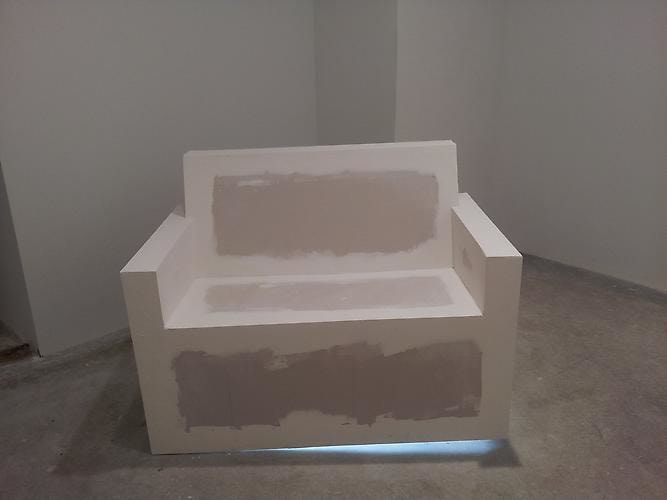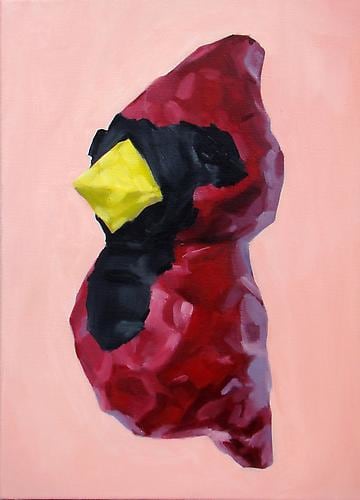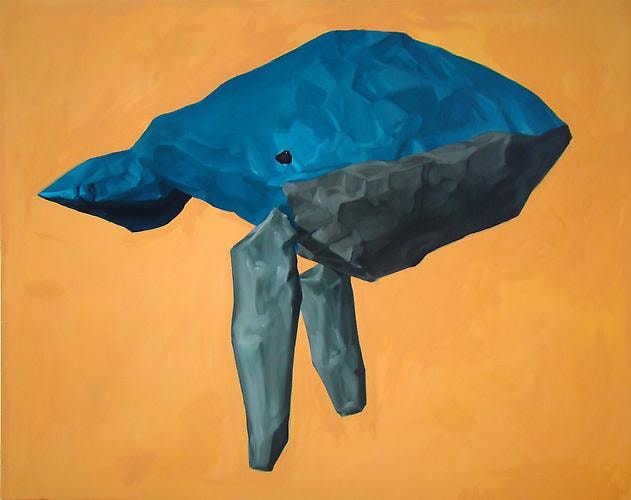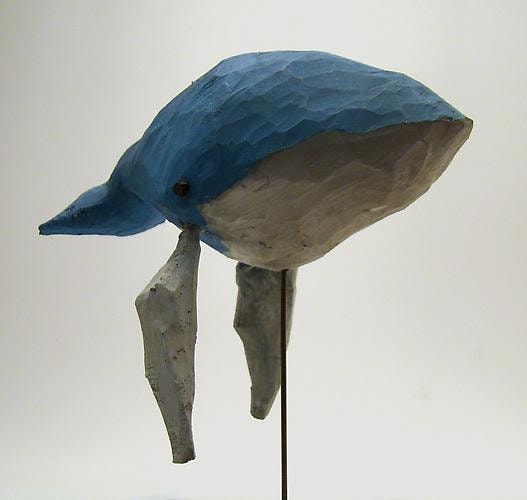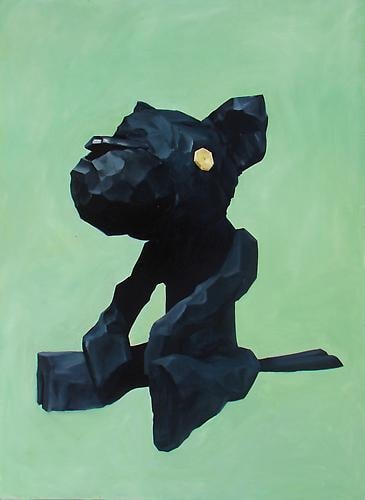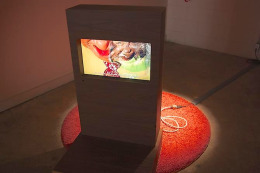Take something. Do something to it. Do something else to it. Now do something else to it." (excerpt from Jasper Johns’ notebooks, circa 1960).
Based on Johns’ classic advice to himself (and artists everywhere) on the creative process, Do Something (Else) To It picks up where Johns leaves off, exploring the current nature of transformation and translation. In the wake of Hurricane Sandy which devastated most of the Chelsea gallery district as we know it, Freight+Volume is proud to inaugurate its newly reconstructed space with an appropriately transformative exhibition by three emerging young artists. Working in diverse media - painting, video, sculpture and installation - these innovators come together via a shared dialogue, reexamining stereotypes of icon, memory, narrative and the artistic process, and presenting them afresh.
The following is a conversation between the artists and curator in early Fall 2012:
NL: I think it would be good to format this press release as a conversation between the four of us. Let’s start with the title of the show, the quote by Johns…
DE: I am thinking about this show in terms of transformation and translation, transformation of materials and objects in space and the translation of materials and form in the mind.
AS: I think the title is pretty perfect when talking about most folks’ process. As it pertains to me, I can't seem to just make one thing for one reason - I am always making things so I can make something else. I suppose I like to control every aspect, not leave anything to chance or not have it exactly what I want it to be. Jasper Johns had some amazing quotes about process... such as "Sometimes I see it and then paint it. Other times I paint it and then see it. Both are impure situations, and I prefer neither."
This guy was thoughtful and had a sense of humor about art. What I find to be most important is that it seems he wasn't very precious about the work... it was something he did, and I can relate to that.
My own process is about not being satisfied with the stuff that's around so I have to make my own. Transformation and Translation is a good way to put it.
The reasoning behind the use of toys is that they are immediately understood. I needed imagery that conjured up ideas of innocence or a simpler time without having to make the audience work too hard. The combination of a colorful, simple child's toy carved in a primitive way forces the viewer to confront something sentimental and non-existent in their day-to-day routine and reinvestigate it through the lenses of maturity. In a world where there is nuclear warfare and also sandwiches, perspective is necessary.
GJ: Johns' quote reads like a formula but really he's pinpointing a basic creative mechanism, which is to repeatedly act on an idea or image. I'm with you guys with regards to transformation and translation. I think that the two are inextricable. For me, its about filtering an idea or image through various mediums, then picking through the refined stuff that passes through that filter as well as the gross clumps that get left behind. Johns' quote serves as a reminder that I must intuitively follow the trail that develops through all aspects of making. I make an object, sit and stare. While I'm having a smoke, I read a word that tells me how to capture the object on video. The next day I'm faced with cleaning up all of the refuse of producing the video and those bits of material suggest another angle of attack. What develops is a train of thought that ultimately makes the decisions for me. A divining rod.
NL: Yes, transformation and translation are the key methodologies in this show. Alchemy of a household object into a potent symbol of memory, sexuality and loss, for example.
George, can you talk a bit about the choice of a blinking toy as the central narrative image in your projected video? And Andy, why the choice of stuffed animals - what is both compelling and significant about them as an object to sculpt and then paint?
GJ: The blinking toy is central to the narrative of that piece because it serves multiple roles. It is a prop that might have been found in the story. It is the character of that story and also a strange omniscient presence. Its obscene mechanical behavior (the perpetual wink and the fellating tongue) is analogous to the images that the text conjures. I'm also interested in taking a grotesque object and endowing it with a touch of humanity. Like with Andy's stuffed animals, we are coaxed into reconciling the piece's touching aspects with its brutality.
NL: Right on. The object/obscene toy as a stand-in for the artist as narrator is a very cool concept too. Like the third-person narrative in a novel. Continued by "Clare," your upside-down monologue video.
GJ: Exactly. There's really only one voice spread among these pieces. It's the same character, unwittingly transplanted in different places and moments in time.
Most of my writing ends up having a subtext about creative process. My guess is that it’s my impulse to dramatize all of the crap that comes with trying to conjure an image that's worthwhile. The video with "Clare" is an attempt to condense a lifetime of that drama into a very concise, intimate moment. A shave.
NL: A close shave. Making art is always about risk and mistakes, and failure and embarrassment, as much as it seems to be about the pursuit of success.
GJ: Yep. The more vulnerable I make myself to the process and the more exposed I am in the work, the better the chance that a piece will be successful.
NL: Don, is there a specific object (household, found or otherwise) and narrative thread of transformation in your work you'd like to comment on. I'm thinking of pieces I've seen on your site such as the plywood sofa, elevated chair in the woods, or re-contextualized turf as examples...
DE: I will be working with a transformed couch, a non-traditional shelf and potted houseplants. I believe these objects function as signifiers that conjure familiarity and memory as themes in my work. These objects will be juxtaposed with a abstract sculpture made of 2x4 studs and a few small paintings created by repeatedly applying acrylic house paint to the support over and over again with a paint roller where each of the dozens of layers is a new transformation. The wood sculpture and paintings are abstract models of growing, evolving systems (much like the living house plants are in fact growing systems) and employ entropic gestures as the primary organizing principle. The abstract works relate to my previous work that dealt with modeling the universe. I am creating a kind of living room that combines commercial building materials with familiar domestic forms and actual living objects in an attempt to create a dialogue around themes of growth, memory, transformation and the human capacity for imagination.
NL: That sounds awesome. Gives new meaning to the term "couch potato" - a garden in one's Living Room. I think the abandoned frat basement George conjures up in his projection relates well to Don's middle room, and certainly the playroom toys Andy presents play off a living room idea as well. The inanimate vs. the animate is a recurring theme here too. Manufactured emblems of life rather than actual breathing beings.
Any comments on the idea of emblems as models for larger realities? Duchamp’s urinal, for example, as a landmark art-object signifier?
AS: The idea of creating a simulacrum goes all the way back to our ancient brothers and sisters needing to look their gods in the eyes. We create these models or find these forms in order to order the chaos. In ancient times they carved Zeus out of marble, Duchamp found a porcelain toilet. The innovation and distortion continues.
GJ: And we create them in order to get closer to the intangible. Models are an expression of desire, as are the ready-mades. A model is a great way to amplify polarity. Eight inches equals eight hundred thousand light years. Through these objects, something minute and intimate converges with the massive and grandiose.
About the artists:
Don Edler: Born in Bremen, Germany, Don Edler is a sculpture and installation artist focusing on site-specific works made of commercial construction materials, cast materials and organic matter. Inspired by metaphysics and cosmology, Don emphasizes the importance of the capacity for imagination and poetics as he investigates issues such as the overall form of the universe, energy politics and the role of art in his life. Don Edler studied sculpture at the University of Florida and was a participant at Skowhegan School of Painting and Sculpture. Don lives and works in New York City.
George Jenne: Born in Richmond, VA in 1973, George Jenne makes sculpture, video and installation. He has exhibited at numerous venues including Exit Art, PS 122, The Center on Contemporary Art, Jack the Pelican Presents, and Frosch & Portmann. His work has been reviewed in The New Yorker, Art in America, and the Washington Post. He is a former faculty member of the Rhode Island School of Design and is currently a teaching fellow at the University of North Carolina at Chapel Hill. Jenne splits his time between New York City and North Carolina.
Andrew Smenos: Born in 1981 in Chicago, IL, Andrew Smenos is a graduate of The Ringling College of Art and Design. He is a painter and sculptor whose work has been featured in numerous publications including The New York Times, Reuters and National Public Radio. Andrew lives and works in Brooklyn, New York.
Please join us to celebrate this exhibition and the reconstruction of F+V at a public reception on Thursday, Nov 29th from 6-8pm.
For more information please contact Nick Lawrence at 212-691-7700 or email nick@freightandvolume.com.

